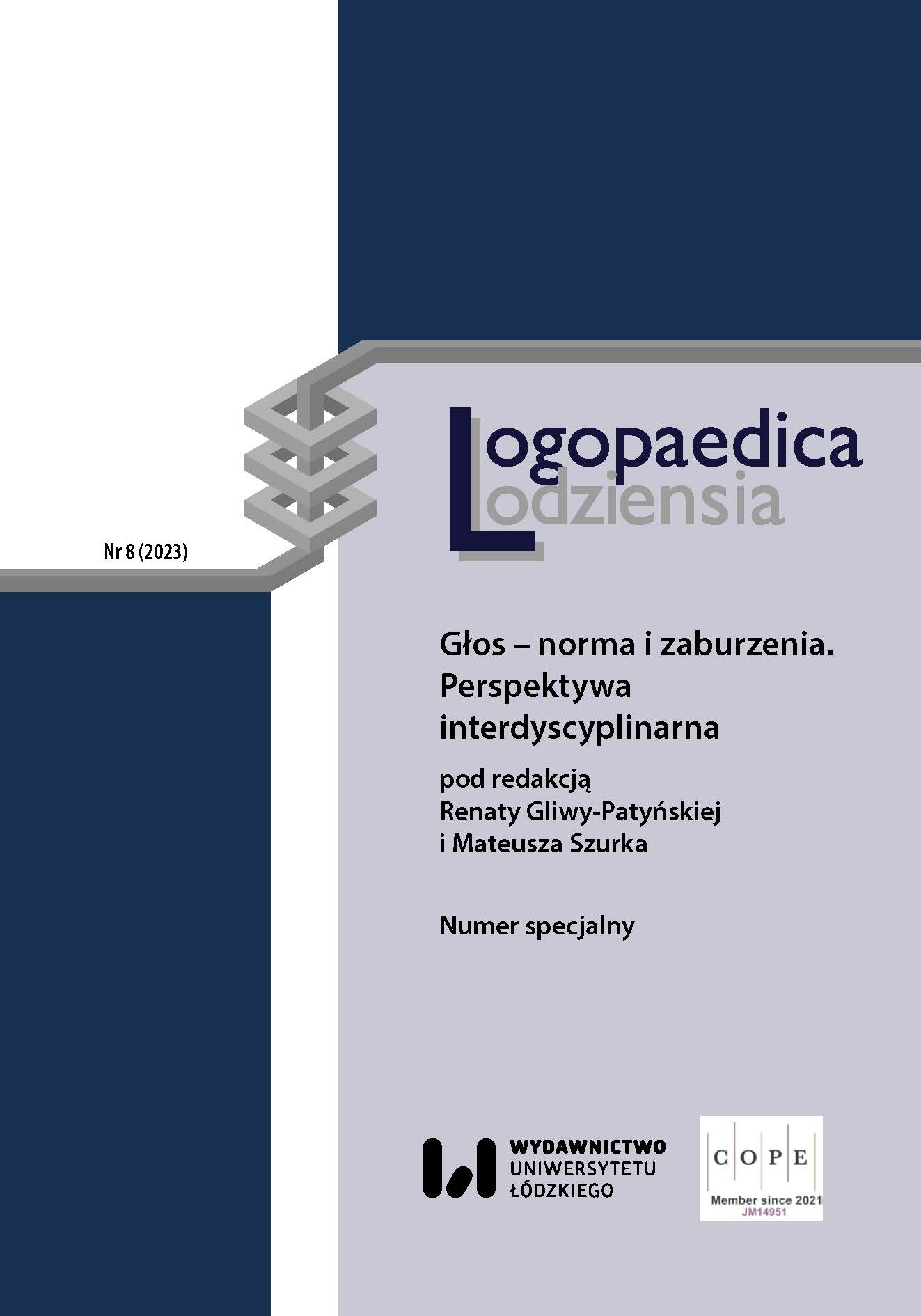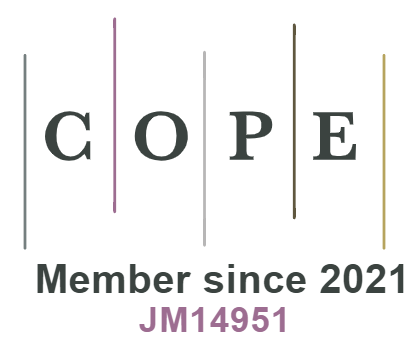Ocena prozodii mowy u pacjentów z dysfonią
DOI:
https://doi.org/10.18778/2544-7238.08.14Słowa kluczowe:
dysfonia, prozodia mowy, ocena prozodii, zaburzenia prozodyczneAbstrakt
Artykuł stanowi próbę uporządkowania problematyki związanej z diagnozą sprawności prozodycznych u osób z dysfonią. Zagadnienia w nim poruszane dotyczą cech charakterystyki prozodycznej mowy, głównie w odniesieniu do języka polskiego, funkcji pełnionych przez prozodię w komunikacji, związku określonych cech fonacji z realizowaniem przez mówcę tych funkcji oraz zaburzeniami ich realizacji u osób z dysfonią. Wymieniono w nim również metody i narzędzia wykorzystywane w opisie i ocenie ekspresji prozodycznej, które można wykorzystać w praktyce klinicznej.
Pobrania
Bibliografia
d’Alessandro C., 2006, Voice source parameters and prosodic analysis, [w:] S. Sudhoff, D. Lenertova, R. Meyer, S. Pappert, P. Augurzky, I. Mleinek, N. Richter, J. Schließer (red.), Methods in Empirical Prosody Research, Berlin–New York: Walter de Gruyter, s. 63–87.
Google Scholar
Bänziger T., Scherer K.R., 2005, The role of intonation in emotional expressions, „Speech Communication”, No. 46, s. 252−267.
Google Scholar
DOI: https://doi.org/10.1016/j.specom.2005.02.016
Binkuńska E., 2020, Prozodia w zaburzeniach głosu, [w:] M. Wysocka, B. Kamińska, S. Milewski (red.), Prozodia. Przyswajanie, badanie, zaburzenia, terapia, Gdańsk: Wydawnictwo Harmonia Universalis, Wydawnictwo Uniwersytetu Gdańskiego, s. 430–453.
Google Scholar
Boersma P., Weenink D., 2023, Praat: Doing phonetics by computer (Version 6.3.10), program komputerowy, https://www.fon.hum.uva.nl/praat/ (dostęp: 30.06.2023).
Google Scholar
Botinis A., Granström B., Möbius B., 2001, Developments and paradigms in intonation research, „Speech Communication”, No. 33, s. 263−296.
Google Scholar
DOI: https://doi.org/10.1016/S0167-6393(00)00060-1
Crystal D., 2009, Persevering with prosody, „International Journal of Speech‑Language Pathology”, No. 11(4), s. 257.
Google Scholar
DOI: https://doi.org/10.1080/17549500902858753
Demenko G., 1999, Analiza cech suprasegmentalnych języka polskiego na potrzeby technologii mowy, Poznań: Wydawnictwo Naukowe Uniwersytetu im. Adama Mickiewicza.
Google Scholar
Epstein M.A., 2003, Voice quality and prosody in English, „Proceedings of the 15th International Congress of Phonetic Sciences, Barcelona”, s. 2405–2408.
Google Scholar
Fox A., 2000, Prosodic features and prosodic structure. The phonology of suprasegmentals, Oxford: Oxford University Press.
Google Scholar
DOI: https://doi.org/10.1093/oso/9780198237853.001.0001
Francuzik K., Karpiński M., Kleśta J., Szalkowska E., 2005, Nuclear melody in polish semi‑spontaneous and read speech: evidence from the Polish Intonational Database PoInt, „Studia Phonetica Posnaniensia”, t. 7, s. 97–128.
Google Scholar
Gussenhoven C., Chen A., 2000, Universal and language‑specific effects in the perception of question intonation, „Proceedings of the International Conference on Spoken Language Processing (ICSLP)”, Beijing.
Google Scholar
DOI: https://doi.org/10.21437/ICSLP.2000-216
Guzy A., 2012, Diagnozowanie problemów emisji głosu, [w:] K. Węsierska (red.), Profilaktyka logopedyczna w praktyce edukacyjnej, t. 1, Katowice: Wydawnictwo Uniwersytetu Śląskiego, s. 153–168.
Google Scholar
Hawthorne K., Fischer S., 2020, Speech‑language pathologists and prosody: Clinical practices and barriers, „Journal of Communication Disorders”, No. 87, 106024.
Google Scholar
DOI: https://doi.org/10.1016/j.jcomdis.2020.106024
Jassem W., 1973, Podstawy fonetyki akustycznej, Warszawa: Państwowe Wydawnictwo Naukowe.
Google Scholar
Karpiński M., 2006, Struktura i intonacja polskiego dialogu zdaniowego, Poznań: Wydawnictwo Naukowe Uniwersytetu im. Adama Mickiewicza.
Google Scholar
Karpiński M., Klessa K., 2015, Prozodia niepewności, [w:] M. Danielewiczowa, J. Bilińska, K. Doboszyńska‑Markiewicz, J. Zaucha (red.), Sens i brzmienie, seria „Prace Językoznawcze Instytutu Filologii Polskiej UKSW”, t. VII, Warszawa: Wydawnictwo Uniwersytetu Kardynała Stefana Wyszyńskiego, s. 49–64.
Google Scholar
Klessa K., 2017, Annotation Pro [Software tool]. Version 2.3.2.3., http://annotationpro.org (dostęp: 29.05.2023).
Google Scholar
Laver J., 1995, Principles of phonetics, Cambridge: Cambridge University Press.
Google Scholar
Lipiec D., 2016, Karta badania logopedycznego osób po laryngektomii całkowitej, „Studia Pragmalingwistyczne”, nr 8, s. 105–115.
Google Scholar
Łukaszewicz B., 2018, Phonetic evidence for an iterative stress system: the issue of consonantal rhythm, „Phonology”, No. 35, s. 115–150.
Google Scholar
DOI: https://doi.org/10.1017/S0952675717000392
Łukaszewicz B., Rozborski B., 2008, Korelaty akustyczne akcentu wyrazowego w języku polskim dorosłych i dzieci, „Prace Filologiczne”, t. LIV, s. 265–283.
Google Scholar
Malisz Z., Wagner P., 2012, Acoustic‑phonetic realisation of Polish syllable prominence: a corpus study, [w:] D. Gibbon, D. Hirst, N. Campbell (red.), Text, Speech and Language Technology Vol. 14/15 – Rhythm, Melody and Harmony in Speech. Studies in Honour of Wiktor Jassem, Poznań: Polskie Towarzystwo Fonetyczne, s. 105–114.
Google Scholar
Mertens P., 2022, The Prosogram model for pitch stylization and its applications in intonation transcription, [w:] J.A. Barnes, S. Shattuck‑Hufnagel (red.), Prosodic theory and practice, Cambridge: MIT Press, s. 259–286.
Google Scholar
DOI: https://doi.org/10.7551/mitpress/10413.003.0010
Moore B.C.J., 1999, Wprowadzenie do psychologii słyszenia, Warszawa−Poznań: Wydawnictwo Naukowe PWN.
Google Scholar
Pruszewicz A., Obrębowski A., (red.), 2019, Zarys foniatrii klinicznej, Poznań: Wydawnictwo Naukowe Uniwersytetu Medycznego im. Karola Marcinkowskiego.
Google Scholar
Roubeau B., Chevrie‑Muller C., Saint Guily J.L., 1997, Electromyographic activity of strap and cricothyroid muscles in pitch change, „Acta Oto‑Laryngologica”, No. 117(3), s. 459–64.
Google Scholar
DOI: https://doi.org/10.3109/00016489709113421
Sawicka I., 1995, Fonologia, [w:] H. Wróbel (red.), Gramatyka współczesnego języka polskiego, t. 3, Kraków: Wydawnictwo Instytutu Języka Polskiego PAN, s. 105−195.
Google Scholar
Signorello R., Demolin D., Henrich Bernardoni N., Gerratt B.R., Zhang Z., Kreiman J., 2020, Vocal fundamental frequency and sound pressure level in charismatic speech: a cross‑gender and language study, „Journal of Voice”, Vol. 34(5), s. 808.e1–808.e13.
Google Scholar
DOI: https://doi.org/10.1016/j.jvoice.2019.04.007
Sluijter Α., Heuven V .J. van, Pacilly J.J.A., 1997, Spectral balance as a cue in the perception of linguistic stress, „Journal of the Acoustical Society of America”, No. 101, s. 503–513.
Google Scholar
DOI: https://doi.org/10.1121/1.417994
Sobin C., Alpert M., 1999, Emotion in speech: the acoustic attributes of fear, anger, sadness and joy, „Journal of Psycholinguistic Research”, No. 28, s. 347−365.
Google Scholar
DOI: https://doi.org/10.1023/A:1023237014909
Steffen‑Batogowa M., 2000, Struktura akcentowa języka polskiego, Warszawa−Poznań: Wydawnictwo Naukowe PWN.
Google Scholar
Śniatkowski S., 2020, Pauza i milczenie – ich miejsce i funkcje w zachowaniach komunikacyjnych, [w:] M. Wysocka, B. Kamińska, S. Milewski (red.), Prozodia. Przyswajanie, badanie, zaburzenia, terapia, Gdańsk: Wydawnictwo Harmonia Universalis, Wydawnictwo Uniwersytetu Gdańskiego, s. 123–134.
Google Scholar
Wagner A., 2017, Rytm w mowie i języku w ujęciu wielowymiarowym, Warszawa: Dom Wydawniczy Elipsa.
Google Scholar
Wagner A., Klessa K., Bachan J., 2016, Polish rhythmic database – new resources for speech timing and rhythm analysis, [w:] N. Calzolari, K. Choukri, T. Declerck, S. Goggi, S. Piperidis (red.), LREC 2016, Tenth International Conference on Language Resources and Evaluation, Portorož: European Language Resources Association, s. 4678–4683.
Google Scholar
Wierzchowska B., 1980, Fonetyka i fonologia języka polskiego, Wrocław: Zakład Narodowy im. Ossolińskich.
Google Scholar
Wysocka M., 2015, Narzędzia badawcze do oceny prozodii mowy, „Nowa Audiofonologia” Vol. 4(4), s. 20–27.
Google Scholar
DOI: https://doi.org/10.17431/895469
Wysocka M., 2016, Prozodia mowy – problemy opisu, [w:] B. Kamińska, S. Milewski (red.), Logopedia artystyczna, Gdańsk: Wydawnictwo Harmonia Universalis, s. 213–231.
Google Scholar
Wysocka M., 2022, Percepcja rytmu w muzyce i mowie, „Logopedia”, t. 51, nr 2, s. 211–228.
Google Scholar
Wysocka M., Kwaterkiewicz M., 2018a, Program terapeutyczny usprawniający percepcję prozodii mowy, „Logopedia”, t. 47, nr 1, s. 247–266.
Google Scholar
Wysocka M., Kwaterkiewicz M., 2018b, Program terapeutyczny usprawniający ekspresję prozodii mowy, „Logopedia”, t. 47, nr 2, s. 325–344.
Google Scholar
Wysocka M., Skoczylas. A., Szkiełkowska A., Mularzuk M., 2008, Standard postępowania logopedycznego w przypadku zaburzeń głosu, „Logopedia”, t. 37, s. 243–254.
Google Scholar
Zehnhoff‑Dinnesen A., Wiskirska‑Woźnica B., Neumann K., Nawka T. (red.), 2020, Phoniatrics I: Fundamentals – Voice Disorders – Disorders of Language and Hearing Development, Berlin: Springer.
Google Scholar
DOI: https://doi.org/10.1007/978-3-662-46780-0
Pobrania
Opublikowane
Jak cytować
Numer
Dział
Licencja

Utwór dostępny jest na licencji Creative Commons Uznanie autorstwa – Użycie niekomercyjne – Bez utworów zależnych 4.0 Międzynarodowe.












